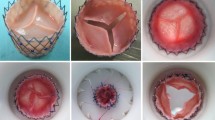Abstract
Objectives: Autologous angiogenic cytokines are known to activated by mincing stimulation, and well regulated in vivo. We applied this tissue fragmentation technique to a low-pressure pulmonary extracardiac conduit to obtain rapid endothelialization and stable neointima formation due to angiogenesis. Methods: Subcutaneous adipose tissue was obtained, minced, suspended, and sieved through highly porous fabric vascular prosthesis by pressurized injection. The adipose tissue fragmented graft with an autologous fresh pericardial monocusp valve was implanted between the right ventricle and the pulmonary artery in 13 dogs. The same grafts without fragments were implanted in 8 dogs as controls. No anticoagulation therapy was given. Results: Grafts were removed 6 to 1,128 days after implantation. In the developed grafts, angiogenesis occurred throughout the interstices of the graft wall from the ad ventitial side, and host cells proliferated and migrated. Endothelialization was completed throughout developed grafts at 2 weeks. The intima was still thin up to 1,128 days and free of degenerative changes. In control grafts, however, capillary infiltration was limited to perigraft tissue at 2 weeks and endothelialization was not completed by 3 months. Under the endothelial cell layer, laminal elastic fibers were formed through the developed graft wall by 4 months and still maintained at 1,128 days. Conclusions: The results demonstrated that adipose tissue fragmented extracardiac conduits induce rapid endothelialization and maintained thin intima with laminal elastic fibers. Long-term durability is expected based on results from using this technique in a low-pressure pulmonary system in dogs.
Similar content being viewed by others
References
Folkman J. Tumor angiogenesis: therapeutic implications. N Engl J Med 1971; 285: 1182–6.
Horn DB, Maisel RH. Angiogenic growth factors: their effects and potential in soft tissue wound healing. Ann Otol Rhinol Laryngol 1992; 101: 349–54.
Silverman KJ, Lund DP, Zetter BR, Lainey LL, Shahood JA, Freiman DG, et al. Angiogenic activity of adipose tissue. Biochem Biophys Res Commun 1988; 153: 347–52.
Tomizawa Y, Noishiki Y, Okoshi T, Nishida H, Endo M, Koyanagi H. Endogenous basic ribroblast growth factor for endothelialization due to angiogenesis in fabric vascular prostheses. Asaio J 1996; 42: M698–702.
Noishiki Y, Tomizawa Y, Yamane Y, Okoshi T, Satoh S, Matsumoto A. Acceleration of neointima formation in vascular prostheses by transplantation of autologous venous tissue fragments. Application to small-diameter grafts. J Thorac Cardiovasc Surg 1993; 105: 796–804.
Noishiki Y, Yamane Y, Tomizawa Y, Okoshi T, Satoh S, Wildevuur CR. Endothelialization of vascular prostheses by transplantation of venous tissue fragments. Asaio Trans 1990; 36: M346–8.
Yates SG, Barros DSAA, Berger K, Fernandez LG, Wood SJ, Rittenhouse EA, et al. The preclotting of porous arterial prostheses. Ann Surg 1978; 188: 611–22.
Guide for the Care and Use of Laboratory Animals. National Institutes of Health, Bethesda, MD, NIH Pub. No. 80-23, rev. 1985.
Agarwal KC, Edwards WD, Feldt RH, Danielson GK, Puga FJ, McGoon DC. Clinicopathological correlates of obstructed right-sided porcine-valved extracardiac conduits. J Thorac Cardiovasc Surg 1981; 81: 591–601.
Stewart S, Manning J, Alexson C, Harris P. The Hancock external valved conduit. A dichotomy between late clinical results and late cardiac catheterization findings. J Thorac Cardiovasc Surg 1983; 86: 562–9.
Imai Y, Takanashi Y, Hoshino S, Nakata S. The equine pericardial valved conduit and current strategies for pulmonary reconstruction. Semin Thorac Cardiovasc Surg 1995; 7: 157–61.
Ando M, Imai Y, Hoshino S, Ishihara K. Autologous reconstruction of pulmonary trunk at reoperation after extracardiac conduit repair. Ann Thorac Surg 1995; 59: 621–5.
Noishiki Y, Tomizawa Y, Yamane Y, Matsumoto A. Effectiveness of fragmented autologous adipose tissue as a sealer of porous textile grafts: effect on endothelial development. J Vasc Surg 1994; 20: 279–87.
Tufro-McReddie A, Norwood VF, Aylor KW, Botkin SJ, Carey RM, Gomez RA. Oxygen regulates vascular endothelial growth factor-mediated vasculogenesis and tubulogenesis. Dev Biol 1997; 183: 139–49.
Noishiki Y, Yamane Y, Tomizawa Y. Sealing of highly porous fabric vascular prostheses by adipose connective tissue fragments instead of preclotting with fresh blood. J Invest Surg 1993; 6: 231–40.
Jonas RA, Mayer JE, Castaneda AR. Unsatisfactory clinical experience with a collagen-sealed knitted Dacron extracardiac conduit. J Card Surg 1987; 2: 257–64.
Kajiwara H, Noishiki Y, Ishii M, Suzuki S, Kosuge T, Mo M, et al. Development of a nonbleeding cardiovascular wall substitute under fibrinolysis phenomenon. Jpn JArtif Organs 1992; 21: 201–205.
Cerfolio RJ, Danielson GK, Warnes CA, Puga FJ, Schaff HV, Anderson BJ et al. Results of an autologous tissue reconstruction for replacement of obstructed extracardiac conduits. J Thorac Cardiovasc Surg 1995; 110: 1359–66; discussion 1366-8.
Bisset GSd, Schwartz DC, Benzing Gd, Helmsworth J, Schreiber JT, Kaplan S. Late results of reconstruction of the right ventricular outflow tract with porcine xenografts in children. Ann Thorac Surg 1981; 31: 437–43.
Jonas RA, Freed MD, Mayer JE Jr. Castaneda AR. Long-term follow-up of patients with synthetic right heart conduits. Circulation 1985; 72 (3pt2): II–77-83.
Bull C, Macartney FJ, Horvath P, Almeida R, Merrill W, Douglas, J et al. Evaluation of long-term results of homograft and heterograft valves in extracardiac conduits. J Thorac Cardiovasc Surg 1987; 94: 12–9.
Ichikawa Y, Noishiki Y, Kosuge T, Yamamoto K, Kondo J, Matsumoto A. Use of a bovine jugular vein graft with natural valve for right ventricular outflow tract reconstruction: a one-year animal study. J Thorac Cardiovasc Surg 1997; 114: 224–33
Skalli O, Ropraz P, Trzeciak A, Benzonana G, Gillessen D, Gabbiani G. A monoclonal antibody against alpha-smooth muscle actin: a new probe for smooth muscle differentiation. J Cell Biol 1986; 103: 2787–96
Sottiurai VS, Batson RC. Role of myofibroblasts in pseudointima formation. Surgery 1983; 94: 792–801.
Gundry SR, Razzouk AJ, Boskind JF, Bansal R, Bailey LL. Fate of the pericardial monocusp pulmonary valve for right ventricular outflow tract reconstruction. Early function, late failure without obstruction. J Thorac Cardiovasc Surg 1994; 107: 908–12; discussion 912-3.
Author information
Authors and Affiliations
Rights and permissions
About this article
Cite this article
Ando, M., Tomizawa, Y., Noishiki, Y. et al. Autologous tissue-fragmented extracardiac conduit with rapid, stable endothelialization due to angiogenesis. Jpn J Thorac Caridovasc Surg 48, 153–160 (2000). https://doi.org/10.1007/BF03218113
Received:
Accepted:
Issue Date:
DOI: https://doi.org/10.1007/BF03218113




